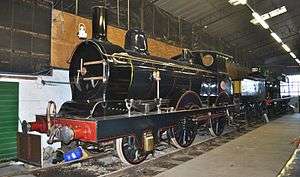GER Class T26
|
GER T26 locomotive 420 | |||||||||||||||||||||||||||||||||
| |||||||||||||||||||||||||||||||||
| |||||||||||||||||||||||||||||||||
| |||||||||||||||||||||||||||||||||
| |||||||||||||||||||||||||||||||||
The GER Class T26 was a class of 2-4-0 steam tender locomotives designed by James Holden for the Great Eastern Railway. At the 1923 grouping they passed to the London and North Eastern Railway, who classified them E4. Eighteen survived into British Railways ownership in 1948, and the last was withdrawn in 1959, making them the last 2-4-0s at work in Britain. Their BR numbers were 62780–62797.
Overview
Derived from the GER Class T19 but with much smaller 5 ft 8 in (1.727 m) driving wheels and intended for mixed traffic work, ninety T26s were built between 1891 and 1896 with 17 in × 24 in (432 mm × 610 mm) cylinders (later 17.5 in × 24 in or 444 mm × 610 mm) and 140 psi (965 kPa) boiler pressure, numbered 417–506. From 1898 some locos were rebuilt with 160 psi (1,103 kPa) pressure boilers thus when an additional ten T26s (numbers 1250–1259) were built in 1902 these were fitted with the new boilers as standard.[1]
Operation
The GER used air brakes but, when introduced, more than half the T26 locomotives were additionally fitted with vacuum brake ejectors for operating over the lines of other railway companies. T26s were particularly associated with the movement of horses by rail to and from Newmarket Racecourse, and thus travelled widely.[1]
T26s were often used on passenger trains to the Norfolk Coast, particularly Wells and Cromer. After the grouping of 1923 Claud Hamilton 4-4-0s took over most passenger traffic to Wells.[2]
Accidents and incidents
- On 12 July 1913, locomotive No. 471 was run into by an express passenger train at Colchester, Essex due to a signalman's error. Three people were killed and fourteen were injured.[3]
- On 27 May 1931, locomotive No. 7486 was hauling a passenger train that overran signals and was in a head-on collision with a passenger train hauled by locomotive No. 7457 at Fakenham East station, Norfolk. One person was killed and fifteen were injured.[4]
Livery
On introduction the T26 locomotives were painted in the standard GER livery of Ultramarine Blue over an undercoat of French Grey, with black smokebox and vermillion buffer beams and lining. From 1915 locos were not given a top coat and ran in French Grey undercoat but with the boiler bands picked out in black.[5] After the amalgamation of the GER into the LNER in 1923 (the Grouping), the E4s received the LNER mixed traffic livery of black with single red lining and red buffer beams. This lasted until the early 1940s when unlined black with red buffer beams was introduced, and the surviving locos were to carry this livery until their withdrawal.
Preservation

One (GER No. 490, BR No. 62785) has survived to form a part of the National Collection and is currently located at Bressingham Steam Museum. There are Transacord recordings of their gentle chuffing through the byways of East Anglia.
References
- 1 2 "T26 Class 2-4-0 1891-1902". Great Eastern Railway Society. Retrieved 2008-04-15.
- ↑ Hawkins & Reeve 1986, p. ?
- ↑ Trevena 1981, p. 26
- ↑ Vaughan 1989, pp. 74-49
- ↑ "Locomotive liveries". Great Eastern Railway Society. Retrieved 2008-04-28.
- Aldrich, C. Langley (1969). The Locomotives of the Great Eastern Railway 1862–1962 (7th ed.). Wickford, Essex: C. Langley Aldrich. OCLC 30278831.
- Hawkins, Chris; Reeve, George (1986). Great Eastern Railway Engine Sheds Part 1: Stratford, Peterborough and Norwich Districts. Didcot, Oxon: Wild Swan Publications Ltd. ISBN 0-906867-40-1.
- Trevena, Arthur (1981). Trains in Trouble: Vol. 2. Redruth: Atlantic Books. ISBN 0-906899-03-6.
- Vaughan, Adrian (1989). Obstruction Danger. Wellingborough: Patrick Stephens Limited. ISBN 1-85260-055-1.
- Ian Allan ABC of British Railways Locomotives, 1948 edition, part 4, page 23
External links
| Wikimedia Commons has media related to GER Class T26 / LNER Class E4. |
- The Holden E4 (GER T26) 2-4-0 Locomotives — LNER Encyclopedia
